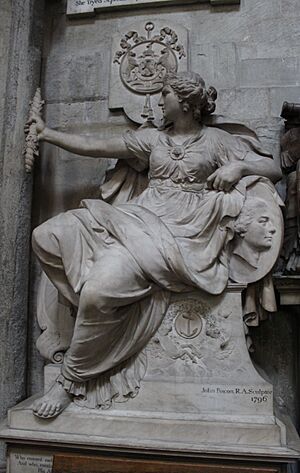George Pocock facts for kids
Quick facts for kids
Sir
George Pocock
|
|
|---|---|

Vice-Admiral George Pocock, by Thomas Hudson
|
|
| Born | 6 March 1706 |
| Died | 3 April 1792 (aged 86) Curzon Street, Mayfair |
| Allegiance | |
| Service/ |
|
| Years of service | 1718–1766 |
| Rank | Admiral |
| Commands held | HMS Cumberland East Indies Station |
| Battles/wars | |
| Awards | Knight of the Bath |
Admiral Sir George Pocock (born March 6, 1706 – died April 3, 1792) was a brave British officer in the Royal Navy. He became a very important admiral and was known for his actions during the Seven Years' War.
Contents
George Pocock was born in Thames Ditton, a town in Surrey, England. His father, Thomas Pocock, was a chaplain who worked for the Royal Navy.
George Pocock started his career in the navy when he was just 12 years old, in 1718. He served on a ship called HMS Superb. He was helped by his uncle, Captain Streynsham Master, who was also a navy officer. By 1725, George became a lieutenant, and in 1733, he was promoted to commander. In 1738, he became a captain and was given command of the ship HMS Aldborough.
Serving in the East Indies
In 1754, Captain Pocock was sent to the East Indies, which is a region in Southeast Asia and India. He joined Rear-Admiral Charles Watson and became captain of the ship HMS Cumberland. Their squadron, a group of warships, worked with Robert Clive to help conquer Bengal in India.
In 1755, Pocock was promoted to rear-admiral. The next year, in 1756, he became a vice-admiral.
When Admiral Watson passed away in 1757, Vice-Admiral Pocock took charge of all the British naval forces in the East Indies. In 1758, he was joined by Commodore Charles Steevens, but even with this help, his squadron only had seven smaller warships.
At this time, Britain and France were fighting in the Seven Years' War. France sent its own naval force to the Bay of Bengal to help their base at Pondicherry. Pocock's main goal was to stop these French ships from reaching their destination.
Battles at Sea
The French fleet, led by Comte D'Aché, had more ships than Pocock, even though some of them were just armed merchant ships. Pocock had to follow strict rules for how to fight, keeping his ships in a line.
Pocock fought three battles against D'Aché, but none of them had a clear winner:
- The first battle was on April 29, 1758, near Cuddalore. Pocock could not stop the French from reaching Pondicherry.
- The second battle was on August 3, 1758, near Negapatam. This fight was more intense, but still, neither side won completely. After this, the French admiral went back to Mauritius.
- Pocock returned to the Bay of Bengal in the spring of 1759 and helped lift the Siege of Madras. The French admiral came back in September. On September 10, 1759, Pocock and D'Aché fought their third battle near Pondicherry. This battle was also very close and did not have a clear winner.
Even though the battles were indecisive, the French government was running out of money. D'Aché could not get the supplies he needed for his ships, so he had to leave the area. This meant the British were left in control of the coasts of India.
Pocock returned home to England in 1760. In 1761, he was honored and made a Knight of the Bath and an admiral.
Later Achievements and Retirement
In 1762, Admiral Pocock was given command of the naval forces for a big mission: to capture Havana, a city in Cuba. The siege of Havana started on June 7 and lasted until August 13. The weather was very difficult, but the British won. Pocock's strong and smart support for the soldiers was a big reason for their victory. He received a large amount of money from the victory, about £122,697.
After returning to England, Pocock was reportedly disappointed because another officer, Sir Charles Saunders, was chosen for a position on the Admiralty Board instead of him. Because of this, he decided to resign from the navy in 1766.
Admiral Pocock's memorial, a statue of Britannia, can be found in Westminster Abbey. It was created by John Bacon and put in place in 1796.
In 1763, Pocock married Sophia Dent. They had a son named George (born 1765), who later became a baronet, and a daughter named Sophia (died 1811).
Sources


